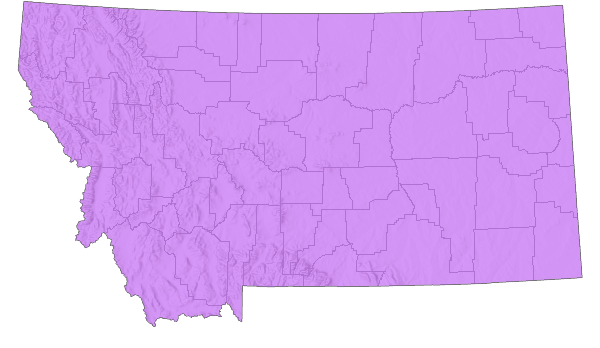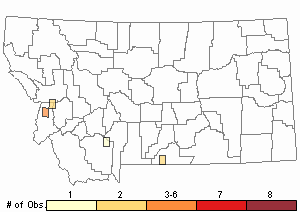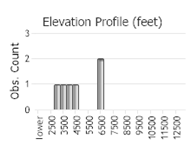View in other NatureServe Network Field Guides
NatureServe
Montana
Utah
Wyoming
Idaho
Wisconsin
British Columbia
South Carolina
Yukon
California
New York
Juba Skipper - Hesperia juba
Native Species
Global Rank:
G5
State Rank:
S5
Agency Status
USFWS:
USFS:
BLM:
External Links
General Description
[From Ferris and Brown 1981; Scott 1986; Layberry et al. 1998, Opler and Wright 1999; Glassberg 2001; Pyle 2002] Forewing 1.5-1.6 cm. Antennal club short relative to antenna length. Uppersurface of forewing with black pattern extending inward in lobes between veins, male stigma with black interior felt; female with two elongate dark spots below discal cell; hindwing slightly translucent showing undersurface pattern. Undersurface of forewing with white spots in greenish-brown apical patch, hindwing dark yellow-brown to greenish-brown with orange along anal margin, large squarish and whitish spots in band, white spot in chevron closest to abdomen offset inwardly.
Phenology
Two flights, mainly May to mid-June and September (Scott 1986). April to June, late August to early October (Glassberg 2001). April to June and August through September in the Rocky Mountain states (Ferris and Brown 1981), mid-May to late June and late August to early October in Colorado (Scott and Epstein 1987), late May to mid-July and mid-August to late October in California (Shapiro 1977, 1979), mid-April to early October on Oregon and Washington (Pyle 2002; Warren 2005), mid-May to June and September in British Columbia (Layberry et al. 1998).
Diagnostic Characteristics
Best determined by a combination of antennal club short relative to antenna length, uppersurface of forewing with black pattern extending inward in lobes between veins, undersurface of hindwing dark yellow-brown to greenish-brown with orange along anal margin, large squarish and whitish spots in band, white spot in chevron closest to abdomen offset inwardly.
Species Range
Montana Range
Range Descriptions

 Native
Native
Range Comments
Southern British Columbia south throughout the western US to northern Baja California, northern Arizona, northwestern New Mexico, east to southeastern Montana, eastern Wyoming, central and western Colorado (Scott 1986; Layberry et al. 1998; Opler and Wright 1999; Glassberg 2001); up to 3292 m elevation in the Rocky Mountain states (Ferris and Brown 1981), to at least 2743 m elevation in northern California (Shapiro 1977), 21 m to at least 2896 m elevation in Oregon (Warren 2005). In Montana, reported from at least 28 counties throughout the state except the northeastern corner (Kohler 1980; Stanford and Opler 1993; FLMNH Lepidopterists' Society database), to at least 1852 m elevation. Mainly common, but rare in eastern Colorado, much of California and Nevada (Glassberg 2001).
Observations in Montana Natural Heritage Program Database
Number of Observations: 11
(Click on the following maps and charts to see full sized version)
Map Help and Descriptions
Relative Density

Recency



 (Observations spanning multiple months or years are excluded from time charts)
(Observations spanning multiple months or years are excluded from time charts)
Migration
Non-migratory, but perhaps migratory in some locations. Possibly wanders long distances, makes spring-summer elevational movements upslope (Pyle 2002; Warren 2005).
Habitat
Sagebrush steppe, arid brushland, dunes, trailsides, grassy hillsides, pine-juniper woodland with grassy openings, dry and wet montane meadows, above treeline in alpine terrain (Emmel and Emmel 1962; Shapiro 1977; Scott 1986; Layberry et al. 1998; Opler and Wright 1999; Glassberg 2001; Guppy and Shepard 2001; Pyle 2002; Warren 2005). Habitat in Montana not described but probably similar.
Food Habits
Larval food plants are grasses, including Agropyron, Aristida, Bouteloua (multiple species), Bromus, Deschampsia, Koeleria, Poa (several species), and Stipa (Scott 1986, 1992; Pyle 2002; Warren 2005); also Elytrigia and Setaria in captivity (James 2009; James and Nunnalee 2011). Adults feed on flower nectar (including Allium, Balsamorhiza, Barbarea, Centaurea, Chrysothamnus, Erigeron, Eriogonum, Erysimum, Harbouria, Heterotheca, Liatris, Medicago, Physocarpus, Senecio, Symphyotrichum, Syringa) and mud (Pyle 2002; Warren 2005; Scott 2014).
Reproductive Characteristics
Females lay eggs singly on or near dead host plant on inflorescense, base of grass clump, sometimes on soil (Scott 1986, 1992; James and Nunnallee 2011). Summer eggs hatch in about 7-14 days, may diapause (overwinter) with well-formed L1 instar if laid late in season and hatch following spring. Larvae develop to L2 instar in about 7 days (depending on temperature), to L5 instar in another 35 days. Spring-laid eggs develp to L5 instar in about 37 days, L5 instar undergoes summer dormancy for about 31 days before pupation in a silk cocoon, sometimes grow to L6 instar before pupation, adults eclose (emerge from pupae) in about 15-16 days. Larvae feed on host plant leaves, live in silk-tied leaf tube-nest, rest in nest when not feeding, overwinter (diapause) as fully-developed egg or L2 instar, sometimes L1 or L3 instars (Scott 1979, 1986, 1992; James 2009; James and Nunnallee 2011); adult possibly overwinters under some circumstances (Shapiro 1979; Berkhousen and Shapiro 1994), but the likelihood of this has been questioned (Scott 1992; Warren 2005; James 2009). Males territorial, perch throughout the day on ground or low vegetation in gullies, rocky depressions, valley bottoms awaiting passing females (Scott 1975b, 1986; James and Nunnallee 2011).
Stewardship Responsibility
References
- Literature Cited AboveLegend:
 View Online Publication
View Online Publication Berkhousen, A.E. and A.M. Shapiro. 1994. Persistent pollen as a tracer for hibernating butterflies: the case of Hesperia juba (Lepidoptera: hesperiidae). Great Basin Naturalist 54:71-78.
Berkhousen, A.E. and A.M. Shapiro. 1994. Persistent pollen as a tracer for hibernating butterflies: the case of Hesperia juba (Lepidoptera: hesperiidae). Great Basin Naturalist 54:71-78. Emmel, T.C. and J.F. Emmel. 1962. Ecological studies of Rhopalocera in a High Sierran Community-Donner Pass, California. I. Butterfly associations and distributional factors. Journal of the Lepidopterists' Society 16:23-44.
Emmel, T.C. and J.F. Emmel. 1962. Ecological studies of Rhopalocera in a High Sierran Community-Donner Pass, California. I. Butterfly associations and distributional factors. Journal of the Lepidopterists' Society 16:23-44. Ferris, C.D. and F.M. Brown (eds). 1981. Butterflies of the Rocky Mountains. Univ. of Oklahoma Press. Norman. 442 pp.
Ferris, C.D. and F.M. Brown (eds). 1981. Butterflies of the Rocky Mountains. Univ. of Oklahoma Press. Norman. 442 pp. Glassberg, J. 2001. Butterflies through Binoculars: A Field Guide to the Butterflies of Western North America. Oxford University Press.
Glassberg, J. 2001. Butterflies through Binoculars: A Field Guide to the Butterflies of Western North America. Oxford University Press. Guppy, C.S. and J.H. Shepard. 2001. Butterflies of British Columbia: including western Alberta, southern Yukon, the Alaska Panhandle, Washington, northern Oregon, northern Idaho, northwestern Montana. UBC Press (Vancouver, BC) and Royal British Columbia Museum (Victoria, BC). 414 pp.
Guppy, C.S. and J.H. Shepard. 2001. Butterflies of British Columbia: including western Alberta, southern Yukon, the Alaska Panhandle, Washington, northern Oregon, northern Idaho, northwestern Montana. UBC Press (Vancouver, BC) and Royal British Columbia Museum (Victoria, BC). 414 pp. James, D.G. 2009. Comparative studies on the immature stages and biology of Hesperia colorado idaho and Hesperia juba (Hesperiidae). Journal of the Lepidopterists' Society 63:129-136.
James, D.G. 2009. Comparative studies on the immature stages and biology of Hesperia colorado idaho and Hesperia juba (Hesperiidae). Journal of the Lepidopterists' Society 63:129-136. James, D.G. and D. Nunnallee. 2011. Life histories of Cascadia butterflies. Corvallis, OR: Oregon State University Press. 447 p.
James, D.G. and D. Nunnallee. 2011. Life histories of Cascadia butterflies. Corvallis, OR: Oregon State University Press. 447 p. Kohler, S. 1980. Checklist of Montana Butterflies (Rhopalocera). Journal of the Lepidopterists' Society 34(1): 1-19.
Kohler, S. 1980. Checklist of Montana Butterflies (Rhopalocera). Journal of the Lepidopterists' Society 34(1): 1-19. Layberry, R.A., P.W. Hall, and J.D. LaFontaine. 1998. The Butterflies of Canada. University of Toronto Press. 280 pp. + color plates.
Layberry, R.A., P.W. Hall, and J.D. LaFontaine. 1998. The Butterflies of Canada. University of Toronto Press. 280 pp. + color plates. Opler, P.A. and A.B. Wright. 1999. A field guide to western butterflies. Second edition. Peterson Field Guides. Houghton Mifflin Company, Boston, Massachusetts. 540 pp.
Opler, P.A. and A.B. Wright. 1999. A field guide to western butterflies. Second edition. Peterson Field Guides. Houghton Mifflin Company, Boston, Massachusetts. 540 pp. Pyle, R.M. 2002. The butterflies of Cascadia: a field guide to all the species of Washington, Oregon, and surrounding territories. Seattle Audubon Society, Seattle, Washington. 420 pp.
Pyle, R.M. 2002. The butterflies of Cascadia: a field guide to all the species of Washington, Oregon, and surrounding territories. Seattle Audubon Society, Seattle, Washington. 420 pp. Scott, J.A. 1975b. Mate-locating behavior of western North American butterflies. Journal of Research on the Lepidoptera 14:1-40.
Scott, J.A. 1975b. Mate-locating behavior of western North American butterflies. Journal of Research on the Lepidoptera 14:1-40. Scott, J.A. 1979. Hibernal diapause of North American Papilionoidea and Hesperioidea. Journal of Research on the Lepidoptera 18(3): 171-200.
Scott, J.A. 1979. Hibernal diapause of North American Papilionoidea and Hesperioidea. Journal of Research on the Lepidoptera 18(3): 171-200. Scott, J.A. 1986. The butterflies of North America: a natural history and field guide. Stanford University Press, Stanford, California.
Scott, J.A. 1986. The butterflies of North America: a natural history and field guide. Stanford University Press, Stanford, California. Scott, J.A. 1992. Hostplant records for butterflies and skippers (mostly from Colorado) 1959-1992, with new life histories and notes on oviposition, immatures, and ecology. Papilio new series #6. 185 p.
Scott, J.A. 1992. Hostplant records for butterflies and skippers (mostly from Colorado) 1959-1992, with new life histories and notes on oviposition, immatures, and ecology. Papilio new series #6. 185 p. Scott, J.A. 2014. Lepidoptera of North America 13. Flower visitation by Colorado butterflies (40,615 records) with a review of the literature on pollination of Colorado plants and butterfly attraction (Lepidoptera: Hersperioidea and Papilionoidea). Contributions of the C.P. Gillette Museum of Arthopod Diversity. Fort Collins, CO: Colorado State University. 190 p.
Scott, J.A. 2014. Lepidoptera of North America 13. Flower visitation by Colorado butterflies (40,615 records) with a review of the literature on pollination of Colorado plants and butterfly attraction (Lepidoptera: Hersperioidea and Papilionoidea). Contributions of the C.P. Gillette Museum of Arthopod Diversity. Fort Collins, CO: Colorado State University. 190 p. Scott, J.A. and M.E. Epstein. 1987. Factors affecting phenology in a temperate insect community. American Midland Naturalist 117(1): 103-118.
Scott, J.A. and M.E. Epstein. 1987. Factors affecting phenology in a temperate insect community. American Midland Naturalist 117(1): 103-118. Shapiro, A.M. 1977. The alpine butterflies of Castle Peak, Nevada County, California. Great Basin Naturalist 37(4): 443-452.
Shapiro, A.M. 1977. The alpine butterflies of Castle Peak, Nevada County, California. Great Basin Naturalist 37(4): 443-452. Shapiro, A.M. 1979. Does Hesperia juba (Hesperiidae) hibernate as an adult? Journal of the Lepidopterists' Society 33:258-260.
Shapiro, A.M. 1979. Does Hesperia juba (Hesperiidae) hibernate as an adult? Journal of the Lepidopterists' Society 33:258-260. Stanford, R.E. and P.A. Opler. 1993. Atlas of western USA butterflies: including adjacent parts of Canada and Mexico. Unpubl. Report. Denver and Fort Collins, Colorado 275 pp.
Stanford, R.E. and P.A. Opler. 1993. Atlas of western USA butterflies: including adjacent parts of Canada and Mexico. Unpubl. Report. Denver and Fort Collins, Colorado 275 pp. Warren, A.D. 2005. Lepidoptera of North America 6: Butterflies of Oregon, their taxonomy, distribution, and biology. Contributions of the C. P. Gillette Museum of Arthropod Diversity, Colorado State University. Fort Collins, Colorado. 406 pp.
Warren, A.D. 2005. Lepidoptera of North America 6: Butterflies of Oregon, their taxonomy, distribution, and biology. Contributions of the C. P. Gillette Museum of Arthropod Diversity, Colorado State University. Fort Collins, Colorado. 406 pp.
- Additional ReferencesLegend:
 View Online Publication
View Online Publication
Do you know of a citation we're missing? Allen, T.J., J.P. Brock, and J. Glassberg. 2005. Caterpillars in the field and garden: a field guide to the butterfly caterpillars of North America. Oxford University Press.
Allen, T.J., J.P. Brock, and J. Glassberg. 2005. Caterpillars in the field and garden: a field guide to the butterfly caterpillars of North America. Oxford University Press. Brock, J.P. and K. Kaufman. 2003. Kaufman Field Guide to Butterflies of North America. Houghton Mifflin Company, New York, NY 284 pp.
Brock, J.P. and K. Kaufman. 2003. Kaufman Field Guide to Butterflies of North America. Houghton Mifflin Company, New York, NY 284 pp. Brown, F.M. 1957. Colorado Butterflies. Proceedings; Numbers Three through Seven. Denver Museum of Natural History, Denver, Co.
Brown, F.M. 1957. Colorado Butterflies. Proceedings; Numbers Three through Seven. Denver Museum of Natural History, Denver, Co. Forister, M.L., C.A. Halsch, C.C. Nice, J.A. Fordyce, T.E. Dilts, J.C. Oliver, K.L. Prudic, A.M. Shapiro, J.K. Wilson, J. Glassberg. 2021. Fewer butterflies seen by community scientists across the warming and drying landscapes of the American West. Science 371:1042-1045.
Forister, M.L., C.A. Halsch, C.C. Nice, J.A. Fordyce, T.E. Dilts, J.C. Oliver, K.L. Prudic, A.M. Shapiro, J.K. Wilson, J. Glassberg. 2021. Fewer butterflies seen by community scientists across the warming and drying landscapes of the American West. Science 371:1042-1045. Forister, M.L., E.M. Grames, C.A. Halsch, K.J. Burls, C.F. Carroll, K.L. Bell, J.P. Jahner, et al. 2023. Assessing risk for butterflies in the context of climate change, demographic uncertainty, and heterogeneous data sources. Ecological Monographs 93(3):e1584. https://doi.org/10.1002/ecm.1584
Forister, M.L., E.M. Grames, C.A. Halsch, K.J. Burls, C.F. Carroll, K.L. Bell, J.P. Jahner, et al. 2023. Assessing risk for butterflies in the context of climate change, demographic uncertainty, and heterogeneous data sources. Ecological Monographs 93(3):e1584. https://doi.org/10.1002/ecm.1584 Hendricks, P. and M. Roedel. 2001. A faunal survey of the Centennial Valley Sandhills, Beaverhead County, Montana. Report to the U.S. Bureau of Land Management and U.S. Fish and Wildlife Service. Montana Natural Heritage Program, Helena, MT. 44 p.
Hendricks, P. and M. Roedel. 2001. A faunal survey of the Centennial Valley Sandhills, Beaverhead County, Montana. Report to the U.S. Bureau of Land Management and U.S. Fish and Wildlife Service. Montana Natural Heritage Program, Helena, MT. 44 p.
- Web Search Engines for Articles on "Juba Skipper"
- Additional Sources of Information Related to "Insects"





